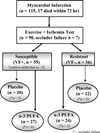Dietary omega-3 fatty acids and susceptibility to ventricular fibrillation: lack of protection and a proarrhythmic effect
- PMID: 22333345
- PMCID: PMC3380163
- DOI: 10.1161/CIRCEP.111.966739
Dietary omega-3 fatty acids and susceptibility to ventricular fibrillation: lack of protection and a proarrhythmic effect
Erratum in
- Circ Arrhythm Electrophysiol. 2012 Aug 1;5(4):e89
Abstract
Background: Recent clinical studies that evaluated the effects of supplemental omega-3 polyunsaturated fatty acids (n-3 PUFAs) on sudden cardiac death have yielded conflicting results. Our aim was to clarify this issue using an established and clinical relevant canine model of sudden cardiac death.
Methods and results: Susceptibility to ventricular fibrillation (VF) was evaluated using a 2-minute left circumflex artery occlusion during the last minute of an exercise test in 76 dogs (from 2 independent studies) with healed myocardial infarctions (MI); 44 developed VF (susceptible, VF+), whereas 32 did not (resistant, VF-). These dogs were then randomly assigned to either placebo (1 g/d, corn oil; 15 VF+, 11 VF-) or n-3 PUFA (1-4 g/d, docosahexaenoic acid+eicosapentaenoic acid ethyl esters, 29 VF+, 21 VF-) groups. Seven sham (no-MI) dogs were also treated with n-3 PUFA (4 g/d). After treatment (3 months), the exercise+ischemia test was repeated. Dietary n-3 PUFAs produced significant (P<0.01) increases in red blood cell and left ventricular n-3 PUFA levels. Nine post-MI (5 placebo versus 4 n-3 PUFA) and 2 sham dogs died suddenly during the 3-month treatment period. The n-3 PUFA treatment failed to prevent arrhythmias in VF+ dogs (decreased in 27% placebo versus 24% n-3 PUFA, P=0.5646) but induced VT/VF in VF- animals (n-3 PUFA 33% versus placebo 0%, P=0.0442).
Conclusions: Despite large increases in cardiac tissue n-3 PUFA content, dietary n-3 PUFAs did not prevent ischemia-induced VF and actually increased arrhythmia susceptibility in both noninfarcted and low-risk post-MI dogs.
Conflict of interest statement
Figures





Comment in
-
Omega-3 fatty acids, ventricular arrhythmias, and sudden cardiac death: antiarrhythmic, proarrhythmic, or neither.Circ Arrhythm Electrophysiol. 2012 Jun 1;5(3):456-9. doi: 10.1161/CIRCEP.112.971416. Circ Arrhythm Electrophysiol. 2012. PMID: 22715236 Free PMC article. No abstract available.
Similar articles
-
Effect of dietary omega-3 polyunsaturated Fatty acids on heart rate and heart rate variability in animals susceptible or resistant to ventricular fibrillation.Front Physiol. 2012 Mar 27;3:71. doi: 10.3389/fphys.2012.00071. eCollection 2012. Front Physiol. 2012. PMID: 22470351 Free PMC article.
-
Dietary omega-3 fatty acids promote arrhythmogenic remodeling of cellular Ca2+ handling in a postinfarction model of sudden cardiac death.PLoS One. 2013 Oct 18;8(10):e78414. doi: 10.1371/journal.pone.0078414. eCollection 2013. PLoS One. 2013. PMID: 24205228 Free PMC article.
-
Effects of dietary omega-3 fatty acids on ventricular function in dogs with healed myocardial infarctions: in vivo and in vitro studies.Am J Physiol Heart Circ Physiol. 2010 Apr;298(4):H1219-28. doi: 10.1152/ajpheart.01065.2009. Epub 2010 Jan 22. Am J Physiol Heart Circ Physiol. 2010. PMID: 20097770 Free PMC article.
-
The effects of omega-3 polyunsaturated fatty acids on cardiac rhythm: a critical reassessment.Pharmacol Ther. 2013 Oct;140(1):53-80. doi: 10.1016/j.pharmthera.2013.05.011. Epub 2013 Jun 2. Pharmacol Ther. 2013. PMID: 23735203 Review.
-
A comprehensive review and analysis of 25 years of data from an in vivo canine model of sudden cardiac death: implications for future anti-arrhythmic drug development.Pharmacol Ther. 2006 Sep;111(3):808-35. doi: 10.1016/j.pharmthera.2006.01.002. Epub 2006 Feb 17. Pharmacol Ther. 2006. PMID: 16483666 Review.
Cited by
-
Anti-arrhythmic properties of non-antiarrhythmic medications.Pharmacol Res. 2020 Jun;156:104762. doi: 10.1016/j.phrs.2020.104762. Epub 2020 Mar 23. Pharmacol Res. 2020. PMID: 32217149 Free PMC article. Review.
-
Reactive oxygen species-targeted therapeutic interventions for atrial fibrillation.Front Physiol. 2012 Aug 6;3:311. doi: 10.3389/fphys.2012.00311. eCollection 2012. Front Physiol. 2012. PMID: 22934062 Free PMC article.
-
Are the anti-arrhythmic effects of omega-3 fatty acids due to modulation of myocardial calcium handling?Front Physiol. 2012 Oct 1;3:373. doi: 10.3389/fphys.2012.00373. eCollection 2012. Front Physiol. 2012. PMID: 23060805 Free PMC article.
-
Cardiac physiology and clinical efficacy of dietary fish oil clarified through cellular mechanisms of omega-3 polyunsaturated fatty acids.Eur J Appl Physiol. 2014;114(7):1333-56. doi: 10.1007/s00421-014-2876-z. Epub 2014 Apr 4. Eur J Appl Physiol. 2014. PMID: 24699892 Review.
-
Effect of dietary omega-3 polyunsaturated Fatty acids on heart rate and heart rate variability in animals susceptible or resistant to ventricular fibrillation.Front Physiol. 2012 Mar 27;3:71. doi: 10.3389/fphys.2012.00071. eCollection 2012. Front Physiol. 2012. PMID: 22470351 Free PMC article.
References
-
- Dyerberg J, Bang HO, Stoffersen E, Moncada S, Vane JR. Eicosapentaenoic acid and prevention of thrombosis and atherosclerosis? Lancet. 1978;2:117–119. - PubMed
-
- Kromhout D, Bosschieter EB, de Lezenne CC. The inverse relation between fish consumption and 20-year mortality from coronary heart disease. N Engl J Med. 1985;312:1205–1209. - PubMed
-
- Burr ML, Gilbert JF, Holliday RM, Elwood PC, Fehily AM, Rogers S, Sweetnam PM, Deadman NM. Effects of changes in fat, fish, and fibre intakes on death and myocardial reinfarction: diet and reinfarction trial (DART) Lancet. 1989;2:757–761. - PubMed
-
- Nilsen DWT, Albrektsen G, Landmark K, Moen S, Aarsland T, Woie Effects of a high-dose concentrate on n-3 fatty acids or corn oil introduced early after acute myocardial infarction on serum triacylglyerol and HDL cholesterol. Am J Clin Nutr. 2001;74:50–56. - PubMed
-
- Marchioli R, Barzi F, Bomba E, Chieffo C, Di Gregorio D, Di Mascio R, Franzosi MG, Geraci E, Levantesi G, Maggioni AP, Mantini L, Marfisi RM, Mastrogiuseppi G, Mininni N, Nicolisi GL, Santini M, Schweiger C, Tavazzi L, Tognoni G, Tucci C, Valagussa F. Early protection against sudden death by n-3 polyunsaturated fatty acids after myocardial infarction: time-course analysis of the results of the Gruppo Italiano per lo Studio della Sopravvivenza nell'Infarto Miocardico (GISSI)-Prevenzione. Circulation. 2002;105:1897–1903. - PubMed
Publication types
MeSH terms
Substances
Grants and funding
LinkOut - more resources
Full Text Sources

